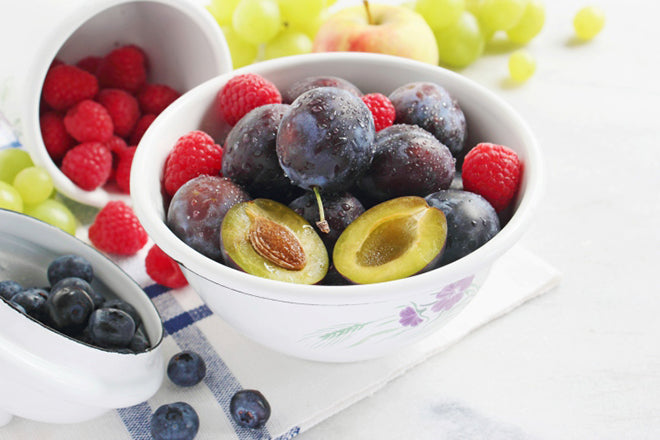A couple of weeks ago we discussed how two toxins can create more damage than each one individually. By contrast, two foods when eaten together can create a sum of nutritional benefits larger than one eaten alone. For example, when you eat a tomato alone, it will give certain nutritional benefit. When you eat broccoli alone, it will provide other nutritional benefits. But, if eaten together, these two create such a nutritional powerhouse that even prostate cancer tumors have been known to shrink.
Elaine Magee, author of Food Synergy found that like whole food supplements, individual nutrients, whether they are in food or in supplements work better when combined with two or three other nutrients.
 Examples of Food Synergy include:
Examples of Food Synergy include:
 Examples of Food Synergy include:
Examples of Food Synergy include:
- Spinach & Vitamin C — Dark green, leafy vegetables like spinach and kale are best eaten in combination with another veggie high in Vitamin C like beets, or a portion of an orange because Vitamin C helps to improve iron absorption in your intestines.
- Tomatoes & Avocados — Tomatoes are rich in an antioxidant called lycopene, which has been proven to reduce the risk of cardiovascular disease and certain cancers. But lycopene is also fat-soluble, which means combining it with a healthy, fat like avocados helps boost absorption even more.
- Oatmeal & Orange Juice — The combination of these morning basics has actually been shown to prevent heart attacks and clean arteries twice as effectively as eating either one on its own. The organic compounds known as phenols (found in both) stabilize cholesterol levels when consumed together.
- Broccoli & Tomatoes — Both contain cancer-fighting properties, but a study at the University of Illinois indicated that the tumor-inhibiting effects are greatly enhanced when broccoli and tomatoes are consumed together.
- Blueberries (Wild) & Grapes — It’s been proven, these fruits mixed together actually have a greater antioxidant response than one fruit eaten on its own.
- Superfood expert Dr. Steven Pratt has touted the immense synergy between blueberries and walnuts for brain health. He believes that blueberries combined with almost every other food will produce synergy.
- Good fats and Veggies — Eating a little "good fat" along with your vegetables helps your body absorb their protective phytochemicals, like lycopene from tomatoes and lutein from dark-green vegetables.
- Grapes and Omega 3 — The polyphenols found in grapes make it easier for your body to absorb omega-3 fatty acids.
- Cruciferous Vegetables (kale, cabbage, Brussels sprout, cauliflower, broccoli, etc.) — Two phytochemicals naturally found in cruciferous vegetables (cambene and indole 3-carbinol) were more active when combined, according to research that tested the compounds individually and together in rats. The researchers found that the two compounds were able to protect the rats against liver cancer much better together activating enzymes that help the body eliminate carcinogens before they harm the genes.
- Foods rich in cambene include Brussels sprouts and certain varieties of broccoli. And all cruciferous veggies are rich in indole 3-carbinol.
- Apples with the peel on fight free-radicals better than apple flesh without the skin. It turns out that the bulk of an apple’s anticancer properties are hidden in the peel. The phytochemicals in the apple flesh seem to work best with the phytochemicals in the peel to reduce the risk of cancer.
- Nutmeg and Mushrooms — These make an unusual combination but since nutmeg is a natural antibacterial it can effectively counter the effects of the bacteria-prone fungus.
Synergy is real. Its effects are measurable and quantifiable.
An example of nutritional synergy is: One-half cup of beans provides the nutritional equivalent (in terms of usable protein) of two ounces of steak, while three cups of whole wheat flour provide the equivalent of five ounces of steak. Eaten at separate times, the two food items contribute the equivalent of seven ounces of steak. But because they each have different amino acids, if the two substances are consumed together they provide the equivalent of nine ounces of steak, or 33 percent more useable protein. Here is a case where, literally, the whole is greater than the sum of its parts. Peter A. Corning, Ph.D. Institute for the Study of Complex Systems There is still much we don't know about how the components in food work together. Case in point: In the past 10 years, scientists have identified hundreds of biologically active plant-food components called phytochemicals (also called phytonutrients). A decade ago, we didn't even know about phytochemicals like lycopene (the one that has made tomatoes famous) or anthocyanins and pterostilbene (which have propelled blueberries into the news). The easiest way to take advantage of food synergies is to eat a wide variety of colorful foods with as many meals as possible. Enjoy the endless possibilities!







